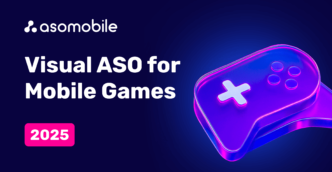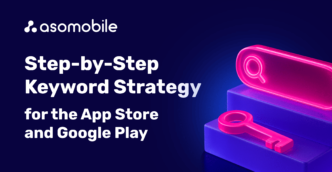What are in-app purchases and how to optimize them for App Store search results?
By visiting the app store, in addition to Categories, Top-lists, and Recommendations, we will see the main two groups of apps and games - paid and free. Everything is quite simple and unambiguous with paid ones - you buy an app with a full range of its functions and all the content. The further fate of your purchase - the income is distributed between the app store and its developers. When you come across free apps, you will most likely be dealing with apps that contain ads or apps with in-app purchases.
At the end of the article, you can find a 40% discount coupon for the first month of using ASOMobile - a tool for creating ASO and researching competitors in the mobile app market.
The creators of free apps or games almost always come to the need to monetize them. After all, an app is not just a solution to any problem, it is a business idea that should bring money. There are several ways to monetize - for example, in-app advertising, in-app purchases, or mixed options.
According to statistics for 2019-2020:

App revenue is growing and is rather unevenly distributed between Google Play and the App Store. Based on the analysis of the categories that bring the most income, you can think of the best strategy for monetizing games and applications.
In-app purchases in apps
Have you noticed that using the app you get a pop-up message about an in-app purchase?
Most often for apps, in-app purchases look like a purchase of full, golden, extra access to all the features of the app.

Pay attention to how the appeal to the user is formed. The purchase is as reasoned as possible, you get a full explanation of the benefits and bonuses when making it. A frequent way to attract users to in-app purchases is a trial - a free trial period, during which you can evaluate the functionality and continue using all the features of the app on a paid basis.
If we analyze more - when exactly the notification about the possibility of in-app purchases occurs. The ability to organically enter a notification and bring the user to the moment of an in-app purchase is very important. Imagine yourself in the user's place - you entered the app (yes, you first found it, i.e. expecting a certain functionality, and installed it), and instead of an interface with a pool of features, you receive a notification about premium access. Most likely, this will scare the user off, because he installed a “free” app (notification of purchases in the application can be ignored) and instead of being able to use it, he receives a price list for various access levels. Beware of such steps, because it will be problematic to return the user to the application.
Another approach would be to combine in-app ads with in-app purchases. A user can buy access to the application without ads and thus get comfortable and uninterrupted use without being distracted by advertising banners and pop-up videos or messages. Remove ads - this can be attributed to one-time in-app purchases. A quite fair approach both for the user - there is an opportunity to use the application for free, and for the developer - monetization through internal purchases and advertising.
Bought it and forgot it?
Since we have already mentioned one-time in-app purchases (no ads), there are other types of in-app purchases worth mentioning.
- Multiple purchases.
Based on the name, it is quite obvious that they can be performed several times, as needed. We will write about them a little later, when we talk about in-app purchases in games. After all, there are many examples: energy, resources and other exhaustible in-game currency or items.
- One-time purchases.
The most common type of ad-free access purchase is a one-time payment for gaining access to certain features, game levels or applications.
- Subscription.
This type of purchase is also used to access additional features and app content. Such accesses usually have an expiration date and may be renewable or non-renewable.
One of the basic rules for in-app purchases is Freemium, a shareware app. This is exactly what we talked about above - the opportunity to try it for free. Music subscriptions are a great example - Spotify offers a free period after which the subscription is activated and you have to pay for your access.
Are in-app purchases just for games?
As you can already conclude - no. In-app purchases are a great way to monetize. Especially if we are talking about applications of the usual use - the average user can always find a subscription.
Basic tips for in-app shopping:
- Offer a choice - no one likes to be cornered. Provide your users with the opportunity to earn virtual bonuses / points / currency by using the application or game, and make virtual purchases at a “mixed rate”. If something can be obtained practically for “just using”, and something only for real money, this creates trust in your application or game and at the same time leads to in-app purchases and revenue.
- Let them try everything - the free trial is our best friend in the matter of getting the user to know all the goodies and features of the application or game. We pay for what we like - a satisfied user is equal to an in-app purchase.
- Don't force your user to search for something similar to you, but for free. By limiting the free functionality, making it a little less convenient and attractive (but still you can use it) - thereby you push the user to upgrade and paid access.
- Package offers and promotions - a notification received at the right moment, with the magic word "discount" or "2 in 1" will always promote in-app purchases. Put multiple purchase options together - package deals are popular.
- Complicating the process and saving time - this is especially applicable to in-app purchases when a player wishing to speed up or facilitate the passage of the game comes to an in-app purchase.
- Rank your pricing plans - don't let them pick from the cheapest or most expensive access. The most expensive option will almost always win if there is a middle one (which is slightly cheaper).
- Removing ads is one step and it is almost a 100% in-app purchase.
In-app purchases in games
In-game purchases are a great way to monetize with a variety of in-game currencies, items, abilities, and ways to simplify the gameplay.
Since the gameplay makes user behavior more predictable, the introduction of internal purchases gives excellent results. At the start, the game gives players the opportunity to familiarize themselves with the process and its gradual complication leads to the need to make an in-app purchase. Speeding up the walkthrough, additional opportunities and abilities of your character - weapons, resources, additional artifacts. All of the above are one-time internal purchases that are consumed during the gameplay and can be purchased again if necessary.
Features of in-app purchases in games:
- As mentioned earlier, in free games you leave the possibility of the walkthrough without in-app purchases, only using the player's perseverance and skills. Thus, you extend the time spent by users inside the game.
- The free or trial approach also works for games - providing the player with an initial supply of a resource so that he can evaluate its usefulness and purchase it on a paid basis in the future.
- Give the opportunity not only to make a purchase, but also to get it through the gameplay.

- One of the options for internal purchases for games is improvement, continuation of the gameplay. An excellent example is when the player is forced to wait for the opening of new levels or locations, or can buy some quick access to them.
- And perhaps most importantly, offer in-app purchases on time. The player lost - give the opportunity to repeat; there is not enough resource - to replenish; saves time - fast walkthrough. Buying offers at the right time is the path to successful monetization.
P.S. All in-app purchases tips can be applied to both apps and games.
Optimization of in-app purchases
In our article on the evolution of app stores, it was mentioned that with the release of iOS 11, we started talking about optimization of in-app purchases. Since in-app purchases may appear in your app store lists, in search results, and may also appear in game or app tabs on the App Store.

If an in-app appears in search results, the user's journey will end up on the page for your app to complete a purchase or to install it.
The rules for getting into the search results are the same for both applications and their in-app, namely, about optimization in particular. In order for in-app purchases to appear in the app store search, they must be formatted accordingly. To do this, you need to enable promotion on the App Store:
- 30-character in-app display name
- Description of the in-app of 45 characters.
These two fields are used to define the keywords that the algorithm will look for when displaying search results.
Each internal purchase has a 30-character Name and a 45-character Description. The best way to optimize it for search is to use keywords that are relevant to your application. Use the most important keywords in the Title and do not duplicate them in the Description.
Keep in mind that you can change the visibility and order of your products, namely how they appear to the user. For example, the in-app will be seen only by those users who have not yet purchased it. You also have the option to make in-app purchases only appear to users who have already downloaded your app.
In-app and their role in forming the semantic core of the app.
In the process of app optimization, in-app purchases can also serve as a source of semantics. And with the help of the ASOMobile mobile analytics platform, it is possible to see for which key queries certain internal purchases of games and applications are indexed. It is especially important to use this information for text optimization of an app(based on iOS) in those categories where standard methods of working with the semantic core are not enough due to the novelty of the app or a narrow niche.
Using the In-App Keywords tool, you can analyze all the keywords by which a selected In-App purchase or a competitor's In-App purchase is indexed, and you can also evaluate search queries thanks to accurate data on the potential traffic volume, complexity and efficiency for each query. All of this can also be checked for relevance in relation to your apps, thanks to quick access to the App Store search results.

The data is updated once every 48 hours, to update the information it is possible to add the queries you are interested in in the In-App Monitor. A handy tool to track changes in the positions of In-App purchases by search queries (available only for apps on the App Store).

So, we figured out what in-app purchases are, their importance for monetizing apps or games, and the way they function. And also how you can use in-app purchases as a source of search queries for text-based optimization of your app.
 Українська
Українська  Русский
Русский  Español
Español 








